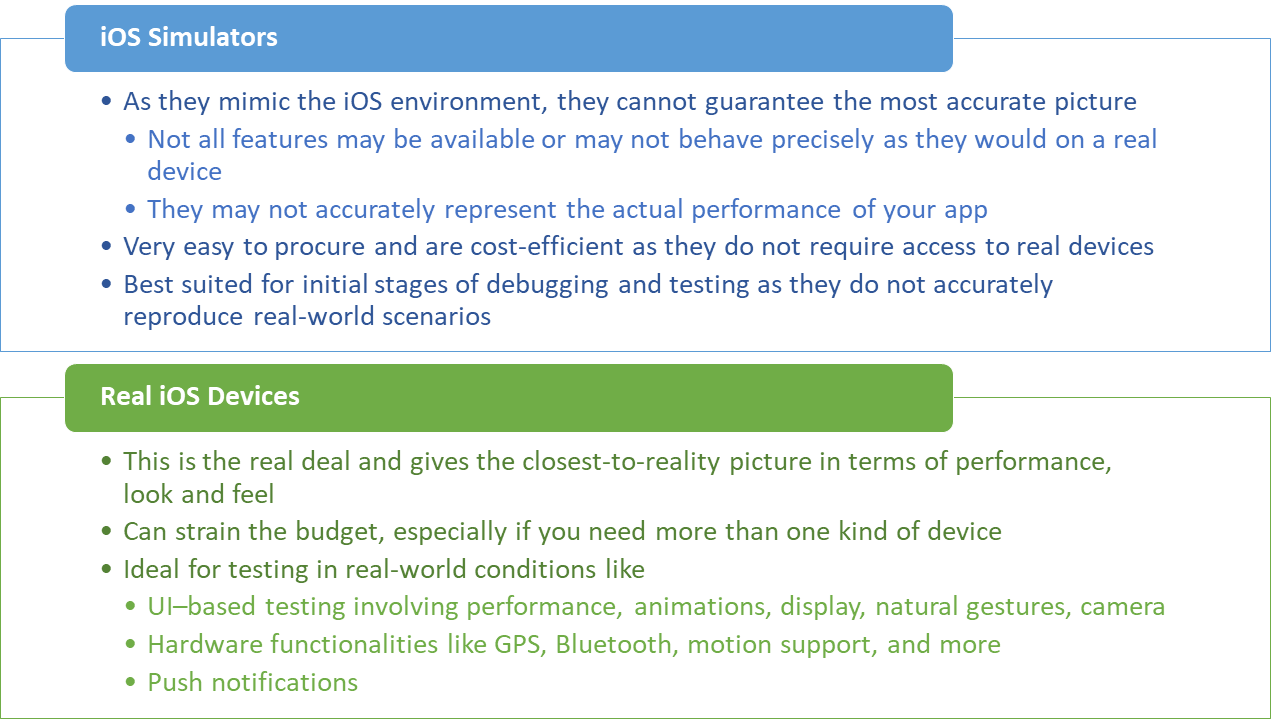Comparing iOS Emulators/Simulators with Real iOS Devices
|
|
Apple is one of the most popular tech giants around the globe. They offer many devices that sell like hotcakes in the market. Rightly so since Apple promises and delivers top-notch products to its customers. Now, if you are an app developer, a gamer, or simply an iOS enthusiast, you know that procuring and maintaining these devices requires an investment. Yet, achieving a close-to-real iOS environment is not impossible, thanks to emulators and simulators.
What are emulators and simulators?
In essence, both emulators and simulators give you the same end goal – a virtual environment to run applications of another OS. When it comes down to terminologies, you will quite often see that both these words are used interchangeably. There however do exist some differences in these two.
An emulator mimics the hardware and software specifications of another system whereas, a simulator provides an imitation of just the software environment. In that sense, you can see emulators are a cross between simulators and real devices. However, they may not replicate all device-specific behaviors accurately.
iOS simulators are provided by Apple as a part of their development tools in Xcode, the official integrated development environment (IDE) for iOS app development. They run applications natively on Mac’s architecture, which can make them faster and more efficient for development and testing.
Why are they so popular?
Emulators and simulators are very popular in the mobile community for many reasons.
The primary one is that they are cost-efficient and readily available as opposed to real devices. Mobile devices are rife, and can even be considered as the life and blood of many. The ease of using mobile devices is further enhanced by the use of mobile apps that offer a good user experience while getting the job done.
The App Store alone offers nearly 2 million apps and not everyone has access to a real iOS device. Not to mention, the budget needed to procure and maintain these devices is not a small one as it includes regular maintenance and OS updates. Hence, alternatives like emulators and simulators behave as a great route to experience that sought-after iOS environment.
Comparison with real devices
Having spoken so highly about emulators and simulators, let’s try not to get carried away just yet. It is a fact that the performance and quality that one can get by running an app on a blue-blooded iOS device like an iPad or iPhone is unparalleled.
Here’s what both these mediums of iOS environment have to offer.

Finding the right balance for mobile testing
From the above discussion, you must have deduced that both real devices and emulators or simulators have their sets of pros and cons, and neither cancels out the other. For those who are using emulators and simulators with the intent to play games or use mobile apps on PCs, this solution works well. But if you are one of those people who are aiming at app development and testing, then you can make the most if you use both in combination.
When it comes to mobile testing, a good test strategy is to use simulators and emulators in the earlier stages of the development cycle and then rely on real devices to do those few rounds of testing that will give the exact feedback on how the app is working under real-world conditions. As the test load increases, employing automated testing to take care of repetitive testing tasks will help you make the most of these technologies.
Using testRigor for iOS testing
Choosing a competent test automation tool for mobile testing is very important. The chosen tool should reduce your burden rather than add to it in the form of extensive test maintenance, flakey test runs, and difficulty in test creation.
testRigor is one of the few tools in the market that uses generative AI at its best to fulfill every test engineer’s dream – ultra-easy test creation with bare minimum test maintenance. The tool does this through a plethora of features like allowing users to write tests in plain English language.
Platform-specific intuitive commands, and easy integrations with other tools and frameworks so that you can expand your testing ecosystem. The tests that you create for the iOS platform are run using simulators and emulators by testRigor. What’s more, is that you can integrate with infrastructure-providing services like BrowserStack to access a larger variety of devices to test, making cross-platform testing easy.
Conclusion
Both real iOS devices and emulators/simulators have their roles in the app development process. Real devices are essential for ensuring accurate performance and testing real-world conditions, while emulators/simulators are useful for quick development iterations and basic testing. The choice depends on your specific needs, budget, and development stage. Many development teams use a combination of both for a comprehensive testing strategy.
| Achieve More Than 90% Test Automation | |
| Step by Step Walkthroughs and Help | |
| 14 Day Free Trial, Cancel Anytime |












